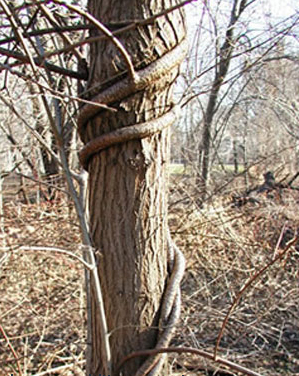
 |
| services | about | contact | resources | work |
Contending with Invasive PlantsOverview For as long as humans have traveled they have been bringing plants along with them. Plants and seeds are either carried intentionally for agriculture or garden applications, or they are inadvertently transported along with other cargo. As our ability to transport goods over greater distances has increased, and agriculture and other development of land have expanded, so to have the quantities of plants and seeds being moved from their region of origin to a part of the globe where they have not previously existed. In most cases these introduced plants are unable to reproduce well without our assistance. Some introductions, however, have not only survived well on their own but have proliferated so successfully in their new environs that they have become a nuisance to farmers, city officials and homeowners alike. In some cases these introductions are crowding out native plant populations in wilderness areas. Just a handful of exotic invasive species can gradually unravel the diverse and complex ecosystems which have developed over millennia. |
|
| Oriental bittersweet vines smothering trees. |
Until quite recently there was little concern for the potentially negative consequences introduced plant (as well as animal) species have on native communities or, for that matter, on developed land. Concern for the issue, however, has been growing in recent years as the impacts of aggressive exotic species are being felt more directly and acutely. For decades plant species now classified as invasive have been readily available (and in many cases promoted) through the nursery industry often times based on their “reliable” performance. The Commonwealth of Massachusetts has recently introduced a phased ban for production and importation of many of these and other problem plant species. Pandora’s box has, however, already been opened allowing populations of some of the most prolific and aggressive species to extend beyond any possible eradication. Only through the enlightened leadership of governments on all levels, and the resolve of local communities and individuals can areas currently threatened by invasive species be, first, recognized and then attempts made to at least curb their continued spread. |
 |
Oriental bittersweet vine girdling a tree. |
 |
At Home One of the best ways to avoid invasive or potentially invasive tree and shrub species in your landscape is, naturally, to not plant them in the first place. If a nursery plant is described using terms such as “aggressive” or “prolific” think twice about introducing it into your landscape. If invasive plants are already present on the property then the sooner they are removed the less difficult the task, and the less opportunity the plants have to spread into the surrounding landscape. More important than the initial removal of invasive plants is having a strategy in place for how to managed a site once cleared of invasive species. If an area is overrun with an invasive species there is a likelihood that simply removing the plant will not solve the problem because the conditions which allowed the plants to take hold in the first place are likely still present. There are a few basic approaches for reducing an invasive plant's ability to regain control of an area once removed. If you are, for instance, trying to develop a flower garden in a sunny area and the source for an invasive plant remains, say in the form of windblown seeds from a neighbor’s trees or shrubs, then these seeds and/or seedlings simply need to be removed as soon as they appear. Another approach, and one that offers far greater botanical interest, is to gradually establish a native planting scheme, or at least a scheme that does not rely on invasive plant species. Over time such selections can, if well chosen, discourage attempts by invasive plants to regain a foothold. Such an approach does require a good knowledge of plants and their cultural requirements in order that the plants selected will stand a fighting chance against tough competition from invasive plants. Vigilant monitoring and removal of unwanted species will still be needed, however, as the new plants become established they will greatly reduce opportunities available to invasive plants to take hold. |
Garlic mustard mono culture established on an unmanaged lot. |
|
© 2006 Garden by Design Inc. All rights reserved. |